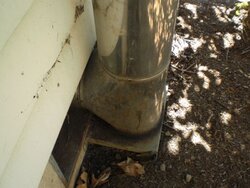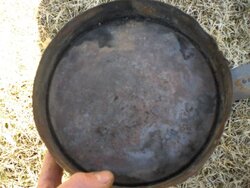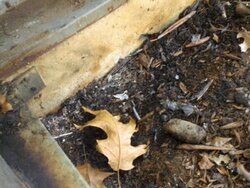I have been burning for five years now and have heard of several chimney fires but never thought I would have one. My setup is a Fireview in the basement of a ranch home. 16 Feet of triple wall chimney (8†inside diameter) along the outside of the house connected to a rise of another 2-3 feet of single wall inside. I burn dry wood, stacked and seasoned for two years and future years will be closer to three. Unfortunately I burn mostly Red Oak, and I’ve had a couple of pieces sizzle. This was my second year burning with the Fireview and I didn’t have much creosote last year. My plan was to inspect and sweep the chimney towards the end of January but because of the snow this year, skipped that ritual.
My three cords only lasted until the beginning of March but my girl hates the cold so under pressure from her I burned some marginal at best Swamp Maple that I was going to use next year. Some of the pieces hissed a bunch and a couple had water sizzle out the ends but the majority of the pieces burned quick but hot.
The last Sunday of March I was cutting up some rounds at the far end of my property and I noticed a big puff of smoke come from the chimney. I thought it was a little odd since the stove was winding down and the stove top shouldn’t have been much over 300 or so. I finished up and a couple of minutes later walked down and went to check out the stove. The moment I walked into the basement room I got a strong leaf burning smell. Stove was 250-300, I don’t recall the specifics but it was definitely cooled down and only had coals left. I went outside and found ashes all around the triple wall and the ground was steaming/smoking. It didn’t take but a half gallon of water to put it out but a rock beneath the surface of the ground was too hot to touch.
I grabbed my welders glove that I use for the stove and removed the ashes and mulch. I found ashes under the bottom of the chimney and to the right hand side of the chimney for a distance of 3 feet or so. The wind blows leaves up against the side of the house and I’m guessing it must have built up under and to the side of the chimney. The pipe was warm to the touch at first but was cold an hour later. The next day when I hopped on the roof and ran the brush down, I had some creosote at the cap but not much down below. I dug out under the pipe and with just my hands was able to take the bottom plug off without any tools. The pipe sits about two inches off the ground and I’m assuming was held in place with the loose rocks/gravel that I removed. The plug was almost filled to the top with creosote that I had brushed, about 2 inches worth.
Since my foundation is concrete, the fire had gone out on its own and was fueled by a pile of leaves but it is scary to think that something I had total confidence in (my outside chimney) failed. I am seriously considering a second stove for the upstairs and will be visiting a local stove shop to discuss an insert for my fireplace and I will show the installer the plug. I felt the bottom of the pipe and can feel a couple of nails sticking through so it will be hard to get the plug back in there securely (which explains the rocks, the previous owners jury rigged everything). I might have to dig a hole underneath to get a better peak. I am assuming that the plug has been out before because as soon as I removed some of the gravel, I was able to wiggle it out of there. I’m assuming that’s not the way its supposed to be. Any one have any experience with these types of chimneys?
I have already come up with a solution, put a 6†liner in. I had considered putting one in already but was holding off because the Fireview cruises easily at 500-550. I can overheat the 425 sq ft finished part of the basement but only keeps the upstairs in the low 60’s. I still want to do a review of the Fireview but that is for another post. Sorry for the long story but I thought I’d share in case anybody else has a similar situation.
My three cords only lasted until the beginning of March but my girl hates the cold so under pressure from her I burned some marginal at best Swamp Maple that I was going to use next year. Some of the pieces hissed a bunch and a couple had water sizzle out the ends but the majority of the pieces burned quick but hot.
The last Sunday of March I was cutting up some rounds at the far end of my property and I noticed a big puff of smoke come from the chimney. I thought it was a little odd since the stove was winding down and the stove top shouldn’t have been much over 300 or so. I finished up and a couple of minutes later walked down and went to check out the stove. The moment I walked into the basement room I got a strong leaf burning smell. Stove was 250-300, I don’t recall the specifics but it was definitely cooled down and only had coals left. I went outside and found ashes all around the triple wall and the ground was steaming/smoking. It didn’t take but a half gallon of water to put it out but a rock beneath the surface of the ground was too hot to touch.
I grabbed my welders glove that I use for the stove and removed the ashes and mulch. I found ashes under the bottom of the chimney and to the right hand side of the chimney for a distance of 3 feet or so. The wind blows leaves up against the side of the house and I’m guessing it must have built up under and to the side of the chimney. The pipe was warm to the touch at first but was cold an hour later. The next day when I hopped on the roof and ran the brush down, I had some creosote at the cap but not much down below. I dug out under the pipe and with just my hands was able to take the bottom plug off without any tools. The pipe sits about two inches off the ground and I’m assuming was held in place with the loose rocks/gravel that I removed. The plug was almost filled to the top with creosote that I had brushed, about 2 inches worth.
Since my foundation is concrete, the fire had gone out on its own and was fueled by a pile of leaves but it is scary to think that something I had total confidence in (my outside chimney) failed. I am seriously considering a second stove for the upstairs and will be visiting a local stove shop to discuss an insert for my fireplace and I will show the installer the plug. I felt the bottom of the pipe and can feel a couple of nails sticking through so it will be hard to get the plug back in there securely (which explains the rocks, the previous owners jury rigged everything). I might have to dig a hole underneath to get a better peak. I am assuming that the plug has been out before because as soon as I removed some of the gravel, I was able to wiggle it out of there. I’m assuming that’s not the way its supposed to be. Any one have any experience with these types of chimneys?
I have already come up with a solution, put a 6†liner in. I had considered putting one in already but was holding off because the Fireview cruises easily at 500-550. I can overheat the 425 sq ft finished part of the basement but only keeps the upstairs in the low 60’s. I still want to do a review of the Fireview but that is for another post. Sorry for the long story but I thought I’d share in case anybody else has a similar situation.




